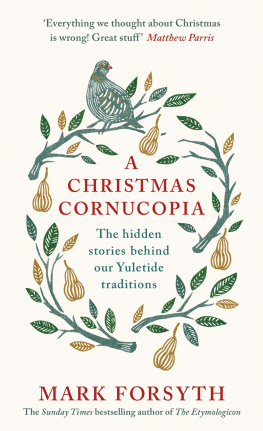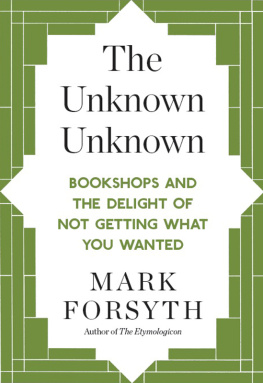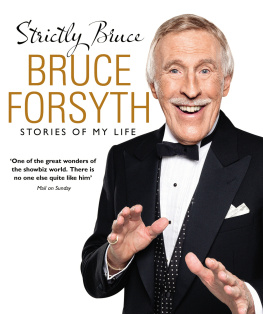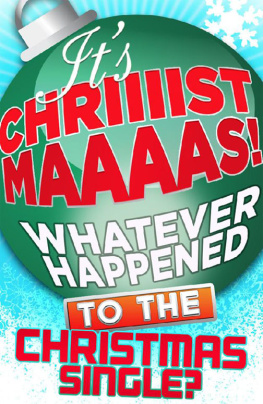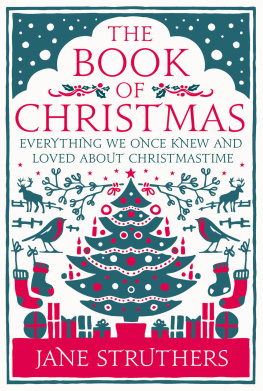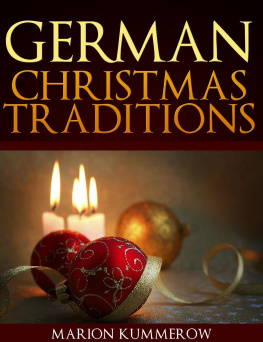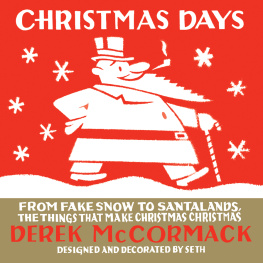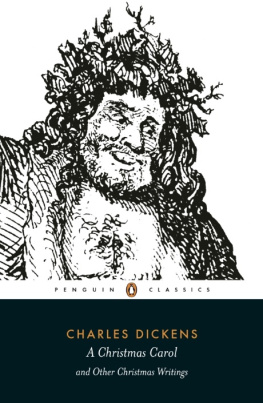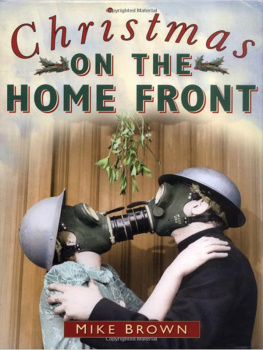Mark Forsyth
A CHRISTMAS CORNUCOPIA
The hidden stories behind our Yuletide traditions
VIKING
UK | USA | Canada | Ireland | Australia
India | New Zealand | South Africa
Viking is part of the Penguin Random House group of companies whose addresses can be found at global.penguinrandomhouse.com.
First published 2016
Copyright Mark Forsyth, 2016
The moral right of the author has been asserted
Grateful acknowledgement is made to Hodder & Stoughton for permission to reprint an extract from Christmas by John Betjeman
ISBN: 978-0-241-97755-2
Preface
Picture a man sitting beside a dead tree. He is indoors and wearing a crown. From the ceiling hangs a parasitical shrub that legitimates sexual assault. He is singing to himself about a tenth-century Mittel-European murder victim using a sixteenth-century Finnish melody. Earlier, he told his children that the house had been broken into during the night by an obese Turkish man. This was a lie, but he wanted to make his children happy. Far away, in the high Andes two Peruvians are punching each other very hard indeed.
And nobody thinks that any of this is odd. Well, actually the Peruvian pugilists are a bit strange, but Ill come to them in a minute. The point is that Christmas is objectively clearly and plainly doolally. It is barmy, barking and bats. If one were to try to explain to an outsider lets say a reasonably bright alien what was going on, they would probably be baffled, and then blow the planet up, just to be on the safe side.
Theres a lovely story about a Tokyo department store, back in the days when Christmas was unknown in Japan. The head of this store had heard rumours of a Western tradition that involved a massive shopping spree and he wanted to introduce it to Tokyo. So he sent some of his staff to investigate, and the result was that on Christmas Eve the shops main window was decorated with a huge Santa Claus nailed to a cross.
Like all the best stories, that story is utterly untrue. But it persists, it persists because it makes us laugh, and it makes us laugh because we wonder how anything that ridiculous could happen at Christmas. When we have stopped laughing, we attach a fairy to the top of the Christmas tree and hang up our stockings by the fire.
Why? Why do we do all these strange things? Why, for a few weeks every year, do we take off our sanity, hang it neatly on the peg and dive into a sea of insanity whilst singing about how we saw three ships? Not only is it strange, what is stranger still is that we do not think its strange. Nobody asks where these traditions come from.
Well, actually, sometimes people do ask. And they tend to come up with two answers, which utterly contradict each other.
Answer number one is that Christmas is all pagan. The lot of it. All pre-Christian stuff from thousands of years ago. The methodology for this is usually something along the lines of: Santa Claus has a beard. Odin had a beard. Therefore Santa Claus is Odin. By this reasoning, Gilgamesh, the King of Ancient Uruk, is in fact Captain Birdseye, because they both have a beard and a boat.
This answer appeals for two reasons. First, its rather romantic to think that we are carrying on a tradition that dates back thousands upon thousands of years into the dark abyss of time. Second, it makes you sound terribly well read and clever.
Answer number two is that Christmas is all Victorian. The whole festival was invented wholesale by Charles Dickens and Coca-Cola, who then used it to sell soft drinks and long novels. This answer appeals because it makes you sound terribly cynical and clever.
A good example of both of these All Pagan! and All Victorian! is kissing under the mistletoe. First the pagan explanation. Several very respectable books will tell you that this all goes back to the death of Baldr. Baldr was a Norse god who was killed by an arrow made of mistletoe. His mother, the unfortunately named goddess Frig, cried and her tears became the white mistletoe berries. Then as her sons cadaver was being loaded onto a very flammable longship, she swore that nobody should ever again suffer from this little plant, and that we should instead kiss under it.
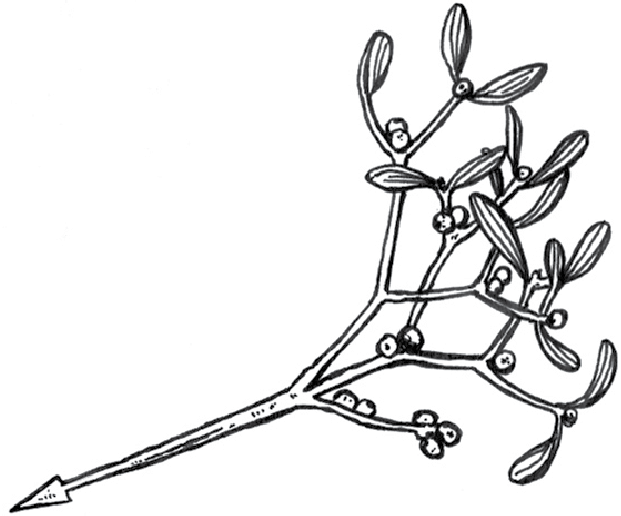
Its a lovely story, but if you dig out the Norse accounts of Baldrs death (there are four of them) youll find that its just not true. Well, the first bit is. Baldr was killed by a mistletoe arrow. Thats it. The rest simply isnt there. No tears become berries. And theres certainly nothing in there about kissing. Instead, Frig is much more Norse about the whole thing. She finds the guy who made the arrow and tortures him for all eternity.
Viking literature contains an awful lot of torture, and very little snogging.
Alternatively, theres the Victorian explanation. You might pull out some equally respectable-looking history books that will tell you that kissing under the mistletoe was invented in 1819 by a friend of Charles Dickens called Washington Irving. Irving was an American writer who wrote a book (for an American audience) called Old Christmas about all the wonderful old yuletide traditions he had observed while staying at an English country house. In it he talks about the custom of kissing under the mistletoe.
Old Christmas was a massive bestseller, first in America and later in Britain itself. It became the standard work on How Christmas Used To Be, and therefore on How Christmas Should Be. People on both sides of the ocean read it as an instruction manual for the real, authentic, unpolluted, traditional Christmas, and then imitated it in their own homes.
However, there were some suspicious cynics who thought that Washington Irving had made most of it up. There are always cynical people in the world, and their case was substantially bolstered when Washington Irving later confessed that he had made most of it up.
But not the mistletoe. A musical came out in 1784 called Two for One, and one of the songs went:
When at Christmas in the hall
The men and maids are hopping,
If by chance I hear them bawl,
Amongst them quick I pop in.
What all the men, Jem, John, and Joe,
Cry, What good-luck has sent ye?
And kiss beneath the mistletoe,
The girl not turned of twenty.
Washington Irving didnt make up mistletoe. Somebody must have at some point. There was a rather curious chap called Sir John Colbatch who wrote a whole book on mistletoe in 1719. But that wasnt enough. Next year, he wrote another one. His books are mainly about how he reckoned that mistletoe could cure epilepsy. But he also wrote down every other thing that he knew about mistletoe, including all the customs and superstitions associated with it. And he doesnt mention kissing. Not once.
So kissing beneath the mistletoe isnt pagan, and it isnt a Victorian invention either. It started sometime between 1720 and 1784 and I dont know why, and I

